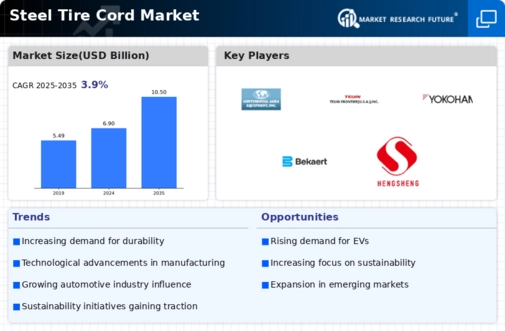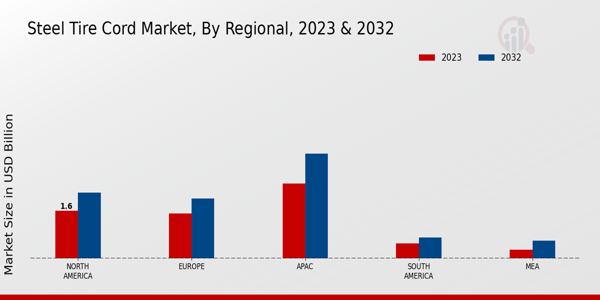Market Trends and Projections
The Global Steel Tire Cord Market Industry is characterized by a steady growth trajectory, with projections indicating a market value of 6.9 USD Billion in 2024 and an anticipated increase to 10.5 USD Billion by 2035. The compound annual growth rate of 3.87% from 2025 to 2035 suggests a consistent demand for steel tire cords, driven by factors such as automotive production growth, technological advancements, and a focus on sustainability. These trends highlight the evolving landscape of the tire industry and the integral role of steel tire cords in meeting future demands.
Growth in Automotive Production
The Global Steel Tire Cord Market Industry is significantly influenced by the growth in automotive production, particularly in emerging economies. Countries such as India and China are ramping up vehicle manufacturing, leading to increased demand for tires that utilize steel tire cords for enhanced strength and longevity. The automotive sector's expansion is expected to contribute to the market's valuation, with a forecasted increase from 6.9 USD Billion in 2024 to 10.5 USD Billion by 2035. This growth trajectory indicates a robust demand for steel tire cords, as manufacturers align their production capabilities to meet the rising needs of the automotive industry.
Increasing Focus on Sustainability
The Global Steel Tire Cord Market Industry is witnessing a shift towards sustainability, as manufacturers and consumers alike become more environmentally conscious. The demand for eco-friendly tires, which utilize steel tire cords for their durability and recyclability, is on the rise. This trend aligns with global initiatives aimed at reducing carbon footprints and promoting sustainable practices within the automotive sector. As a result, the market is expected to grow, with projections indicating an increase from 6.9 USD Billion in 2024 to 10.5 USD Billion by 2035. The emphasis on sustainability may further enhance the appeal of steel tire cords, potentially driving their adoption in tire manufacturing.
Rising Demand for High-Performance Tires
The Global Steel Tire Cord Market Industry experiences a notable surge in demand for high-performance tires, driven by the automotive sector's focus on enhancing vehicle safety and efficiency. As consumers increasingly prioritize performance, manufacturers are compelled to innovate, integrating advanced materials such as steel tire cords. This shift is reflected in the projected market value of 6.9 USD Billion in 2024, with expectations of reaching 10.5 USD Billion by 2035. The compound annual growth rate of 3.87% from 2025 to 2035 underscores the industry's potential for expansion, as automakers seek to improve tire durability and performance.
Regulatory Support for Enhanced Safety Standards
Regulatory support for enhanced safety standards significantly impacts the Global Steel Tire Cord Market Industry. Governments worldwide are implementing stricter regulations regarding tire performance and safety, compelling manufacturers to adopt higher quality materials, including steel tire cords. These regulations aim to reduce road accidents and improve vehicle safety, thereby increasing the demand for high-quality tires. As the market adapts to these regulatory changes, it is projected to grow from 6.9 USD Billion in 2024 to 10.5 USD Billion by 2035, reflecting a broader commitment to safety and quality in tire manufacturing.
Technological Advancements in Tire Manufacturing
Technological advancements in tire manufacturing play a crucial role in shaping the Global Steel Tire Cord Market Industry. Innovations such as automated production processes and improved material formulations enhance the efficiency and quality of tire production. These advancements not only reduce manufacturing costs but also improve the performance characteristics of tires, making them more appealing to consumers. As the market evolves, the integration of cutting-edge technologies is likely to drive growth, contributing to the projected market value increase from 6.9 USD Billion in 2024 to 10.5 USD Billion by 2035, with a CAGR of 3.87% anticipated from 2025 to 2035.







